Shipping Live Crayfish!
09 Friday Sep 2022
Posted in Fish
09 Friday Sep 2022
Posted in Fish
09 Saturday Jul 2022
Posted in Fish
The other day, my juvenile Marbled Crayfish started dying. I found one dead, and then next week, another one. No signs of any injury, no missing appendages, no bacterial infection – just dead, perfectly healthy looking crays.
Then I recalled that I’d seen one of these larger juveniles (2″ or so in length) munching on the edge of a silk plant like this:

A closeup of a frayed/eaten leaf edge:

My conclusion: they ingested these silk fibers and suffered from digestive complications as a result. They proved to be fatal.
I removed all silk plants from my crayfish tanks. The plant in the background in the below image is a fully plastic bamboo plant. No more soft cloth components!
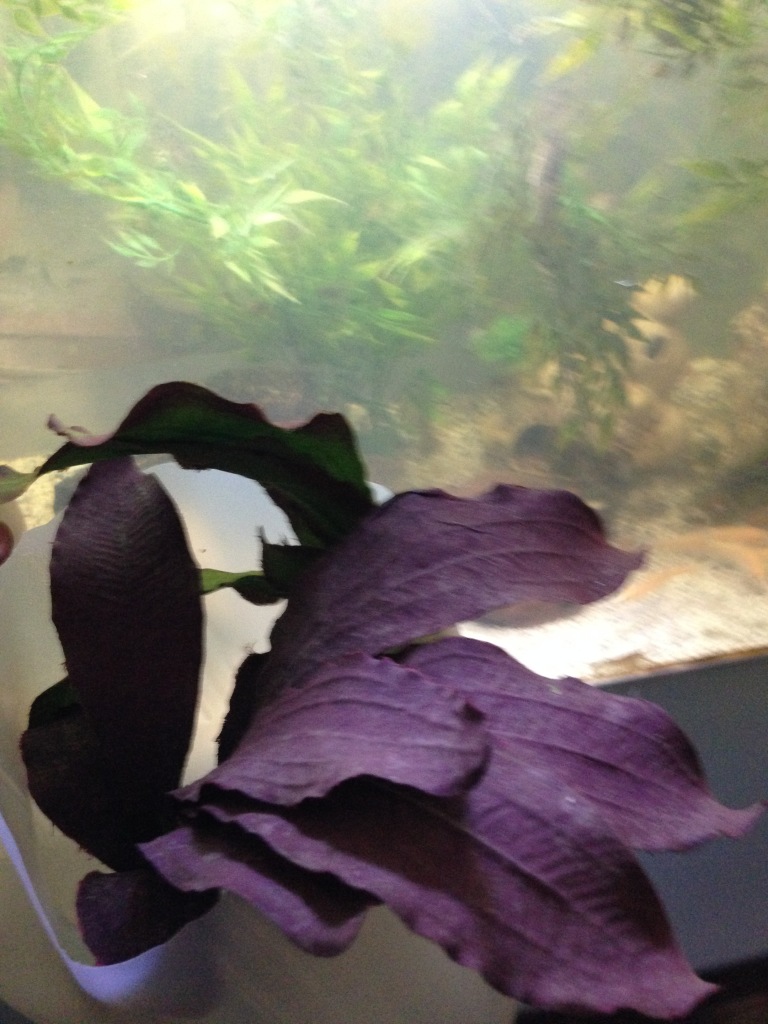
They look good but are not worth the risk. The soft leaves easily accumulate gunk and biofilm, which are attractive to crayfish who come to feed on them. Unfortunately, they also rip into the fibrous material. Maybe it’s not 100% the cause of death, but since I removed the silk plants, there were no more crayfish turning up dead in that tank.
10 Friday Jun 2022
Posted in Fish
The Marbled Crayfish (Procambarus virginalis), aka Marmorkrebs wouldn’t have received much attention if it wasn’t for its self cloning ability. While they’re cool (like all crayfish), there’s nothing striking about a Marmorkreb’s appearance–olive or brown with a marbled pattern, hence their name. Sometimes they can be blue or red, or change color in response to diet or other factors, such as water quality.
A Marmorkrebs (Catherine):

No one knows for sure how the first Marmorkrebs came to be. Genetic studies of the Krebs confirmed that Marbled Crayfish originated in the German aquarium trade sometime in the mid 90’s, and from then on spread to Madagascar, Europe and elsewhere.
Marmorkrebs are close relatives of the Slough crayfish, Procambarus fallax, but unlike these “regular” crays, they’re triploid animals, with 276 chromosomes (3 sets of 92 each) instead of the usual 184. Triploidy occurs when 2 sets of chromosomes come from the mother and 1 set from the father, or 2 from the father and 1 from the mother.
Each of the 3 sets seems to be a variation of the Procambarus fallax chromosomes. 2 are nearly identical, but the 3rd one is distinct enough to indicate that the two original parent Slough crayfish must have come from very different geographical regions.
Just a few of Catherine’s many clones:

Marbled Crays aren’t the only triploid animals. Goldfish, Oysters, Salmon, Trout and even some humans can have 3 sets of chromosomes. However, humans with 3 sets don’t survive for very long, and many commercially farmed animals such as salmon and oysters that are created purposely to be tripoloids are infertile. On the other hand, Marmorkrebs is the only known decapod crustacean to reproduce asexually, with no apparent negative effects on the clones.
Incidentally, Marmorkrebs and Slough crayfish recognize each other as mates, but the Marbled crayfish will still just produce clones of herself after mating with a male Slough crayfish. Possibly, mating triggers the Marmorkrebs to go into breeding mode, similar to the Amazon Molly (Poecilia formosa), but the Krebs will breed anyway, regardless of whether other crayfish are present.
Claws of the Marmorkrebs (first two sets from below, taken from different molts, and possibly different crayfish). At the top are molt-claws belonging to a Procambarus Clarkii, aka White Specter Crayfish.

The self cloning process is kind of magical. One day a Marmorkrebs is sitting alone under a log or in a cave, the only creature in the tank. The next time you see her, she has a “berry” of eggs under her tail and then they hatch and pretty soon you have 300 tiny copies of this crayfish walking around. They climb off her tail, crawl about in her “whiskers” and generally use her as a jungle gym, and she doesn’t bat an eye. They’re all 100% identical clones of the mother, and each in turn will grow up and clone herself into hundreds of more crayfish.
If you look closely at Catherine’s tail section, you’ll see baby crayfish clones about to hatch! She runs around the tank a lot as the fry start leaving her tail, one by one. Goodbye, safety of mother’s pleopods!



Unlike some other cray species, Mama-krebs does not try to snack on her young, so they have an increased chance of survival. And they are very successful at that. They’re hardy, eat literally everything, and their marbled shells provide them with excellent camouflage from predators.
The only thing Marmorkrebs don’t appreciate is salinity. They tend to avoid marshy areas or otherwise salty water, which keeps them from spreading even further than they already have. They can live pretty much anywhere – rivers (both fast and slow), lakes, rice paddies, swamps, brick pits, drainage ditches, and of course, home aquariums and fish ponds. In short, they’re really good at adapting to different conditions and not only surviving, but flourishing and out-competing native species.
For this reason, they’ve been outlawed in the EU, Japan, and the Canadian province of Saskatchewan, as well as in several US states—as of 2022, they are prohibited in Idaho, Missouri, Tennessee, Michigan, Maryland, and more recently, in Ohio under the Lacey Act.
However, I think that picking on one individual does not solve the bigger problem—crayfish don’t have any concept of state lines, so a cray that’s released into the wild either by chance or by an uninformed or careless aquarist in one state has no problems finding its way into another state where it may be an illegal species. The only real solution is to outlaw the Marbled Crayfish in all of the United States.

But (while they’re still legal to keep), they make excellent freshwater pets!
Here’s Catherine the Marbled Crayfish again

And here’s Betty, her daughter

One of Catherine’s many clones:

Some of Betty’s many clones (having a go at each other by claw-parrying):

Fathead Minnows
If you don’t want all the crayfish fry, there’s a solution: Fathead Minnows. This common North American fish is sometimes sold in silver form, as well as the popular Rosy Red or “Tuffy” Minnow variety. They will readily and happily snack on crayfish fry, especially small hatchlings. If you decide to keep some of the crayfish fry, just move them into a refugium or a separate tank of their own.
They are the only fish I trust around crayfish. Minnows are very strong swimmers and are lightning fast, and I have never seen any crayfish induced injuries after over a year of keeping both species in the same tank.
Actually, Minnows are more likely to attack crayfish. They do this by head butting them. I’ve seen it a few times. The Minnows mostly do this while protecting their nests or “egg lairs”, so if a crayfish strays into their territory it will be speedily butted out. After a few attempts, a Marmorkrebs will learn that it’s a no-go and will tend to avoid the Minnow’s cave in the future.
A Minnow “bull” protecting his cave:


As food
I’ve never tried a Marmorkrebs but people say they don’t taste very good. Nevertheless they’re an excellent (and continuously self-renewing) source of protein.
The Blue color variety

Sometimes Marmorkrebs can be blue or can turn blue in response to diet or some other factors, although there is a “true blue” variety of the Krebs. The above crayfish (image courtesy of a customer) was brown to start with but something made it turn blue. Some Astaxanthin rich foods in a Marmorkreb’s diet can cause it to change color.
I’ve kept Marmorkrebs for a few years now and none of them have ever turned blue except one time. By accident, a few very small crayfish got stranded in a waste water bucket after I cleaned the tank. The water quality in that bucket wasn’t very good—it was the tank’s waste water. The next morning, I noticed a group of these small fry at the bottom of the pail. They were quite blue in color. Upon returning to their tank, they changed back to brown within a few days.
Aside from self-cloning, Marmorkrebs do what any crayfish usually do.
They eat:

Molt:


Explore their habitat:

Take naps:

Groom themselves:

Uproot and eat aquarium vegetation (in this case, Betty is eating duckweed):

Occasionally get into fights with each other over a piece of zucchini or other matters:

Most of the time they don’t lose any claws… but sometimes they do.

Some fun facts about crayfish (goes for all crayfish, not just the Marmorkrebs):

Sand grains lying on top of Catherine’s head. This was one of the first pictures of her that I ever took. Note how small her right claw is in comparison to her left claw–she’d lost it, most likely in a crayfish fight. Every time a crayfish molts, any lost limbs or other parts grow a little bigger.

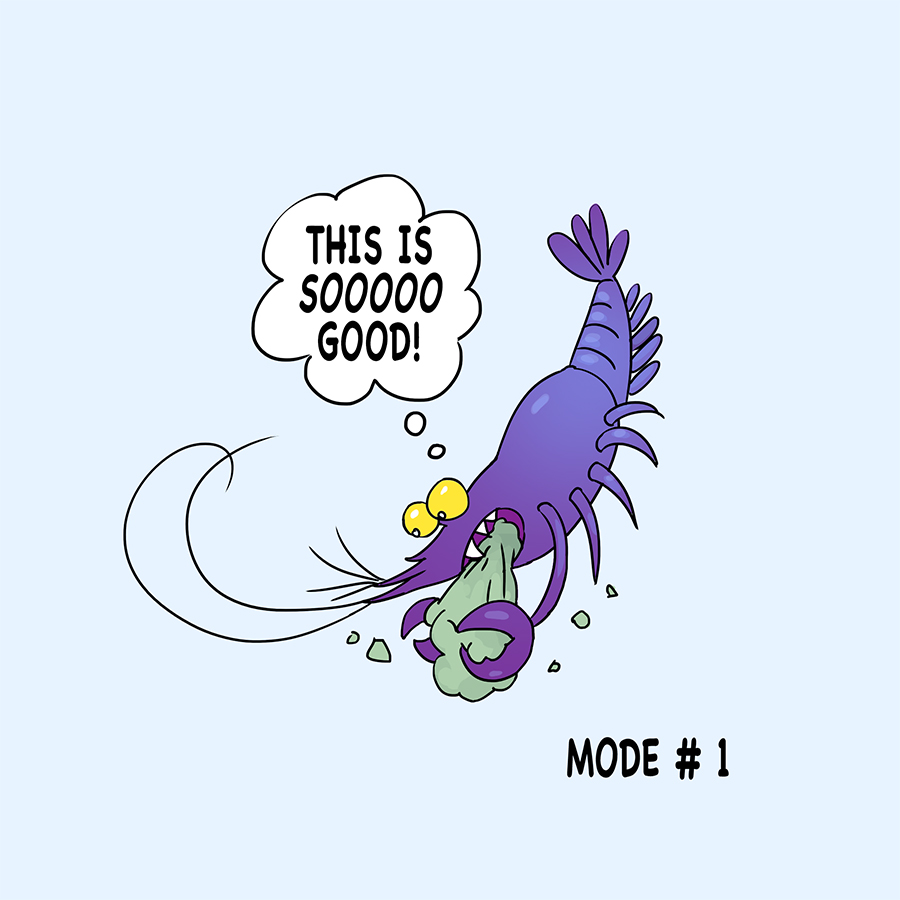

Hey, how about getting crayfish drunk off their tails before cooking them?
05 Sunday Jun 2022
Posted in Fish
Tags
calcium, fish tank, food, how to, mineral blocks, shell erosion, snails

DIY Mineral Blocks for Aquarium Invertebrates
Here’s a quick walk through on how to make mineral blocks for invertebrates such as snails and shrimp. It’s fast and easy to do and your snails, shrimp, crayfish and/or crabs will thank you! The goal is to provide calcium and other vital minerals to your bottom feeding tank crew in an instantly sinking form so they can get to munching right away.
Here’s the recipe:
Step 1
Gather the ingredients:
Calcium Carbonate [high purity grade] — 3 tablespoons
Bentonite [aka Montmorillonite Clay] — 3 tablespoons
Unbleached Wheat Flour — 1/4 cup
Distilled, bottled or conditioned tap water — 1/2 cup
Step 2
Mix all the powder components in a bowl until the mixture looks even.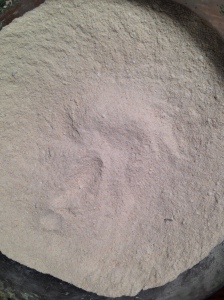
Step 3

Add water and mix well. You might not need to use all the water, just a little at a time until a soft dough forms. It shouldn’t be soupy, just moist enough, kind of like pasta dough. You can always add a bit more flour if the mix is too wet. Knead well.
You can also add protein like this medley of crickets, river prawn and mealworms.
Grind the medley in a coffee grinder to a fine powder. Careful! If not finely ground, you may encounter a few very sharp small bits in the dough such as cricket legs and shrimp jaws [ouch]. Wear gloves or knead with a silicone sheet to protect your hands.
Water can be distilled but I like to use this combo which I use for conditioning tank water anyways:
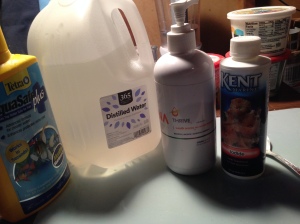
From left to right: Tetra purifier to get rid of chlorine, regular tap water, shrimp safe copper free fertilizer to supply Magnesium, Iron, Molybdenum, etc., and a drop of Iodide. Iodide is strong stuff–the recommended dose of Kent’s Iodide is 2.5 ml (1/2 teaspoon) per 25 gallons of tank water dosed once a month. I prepare the water for my tanks in bulk using 5 gallon pails.
Step 4
There are many ways to process the dough into smaller pieces.
My favorite is running it through a pasta machine like this one: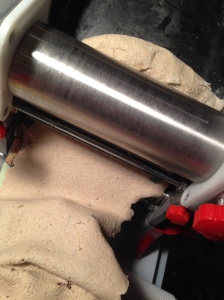
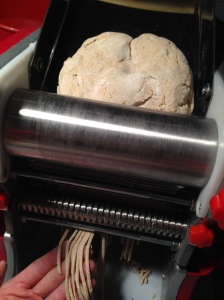
Other ways: rolling the dough out in sheets and cutting it with a rolling pasta cutter or a fondant cutter, or pressing the dough into molds, running the dough through a meat grinder to make “noodles”.

The goal is to make smaller units from this dough which will be convenient to feed later on and they will also dry more quickly and evenly for storage without the risk of spoiling. Big chunks of dough tend to spoil before they dry out thoroughly.
The above batch makes a lot of mineral blocks which will last your tank crew a while!
Step 5
Optional –
You can dry the pellets in a dehydrator (about 3-4 hours) or just leave them out to air dry.
Storage:
I recommend cardboard boxes (such as from noodles or tea boxes) for storing the pellets.
Step 6
Present the food to the panel of experts: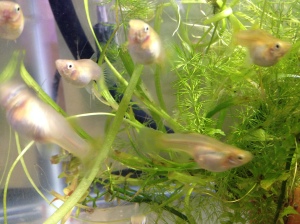
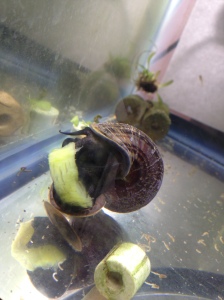
Dough with added Spirulina or Chlorella will be green:
Other stuff you can add: fresh veggies and fruit (grind them up in a food processor first):
Cucumbers, sweet peas, strawberries, zucchini, fresh whole eggs, cabbage, spinach, beets, garlic, lettuce, cauliflower, moringa leaves, dandelions, soybeans, honey, bananas, duckweed… the list goes on!
Some different types of food shapes:
Things to avoid — in general, fish and other tankmates don’t like the following foods:
A note about minerals…
Invertebrates need certain minerals to build up their shells and exoskeletons. Otherwise they’ll experience serious problems which will shorten their life span. For example, calcium deficiency causes white streaks on snail shells and shell erosion, pitting and pinholes. Once the external shell has been compromised, the snail’s internal organs are left vulnerable to parasitic and bacterial infections. Shrimp, crabs and crayfish also need minerals including calcium to successfully molt and build new exoskeletons.
Cuttlebones can also be used as a calcium source, but they look ghastly in a fish tank, and take forever to sink. You can boil them to sink them right away, but either way, they will either float on the surface scaring the fish or sit on the bottom collecting gunk. After a while they start to smell and turn yellowish from all the absorbed stuff.
Next post will be about the Marbled Crayfish!
31 Tuesday May 2022
Posted in Fish
@%$ Fishbowls. Seriously, fuck ‘em. A fish bowl is the dimensional equivalent of a cramped broom closet or a bathtub for a person. Imagine living in one of these:

Eeek.

So, no, NO FISH of any kind should ever be kept in a fishbowl, even if filtration is provided ‘cause it’s well… it’s just too small.
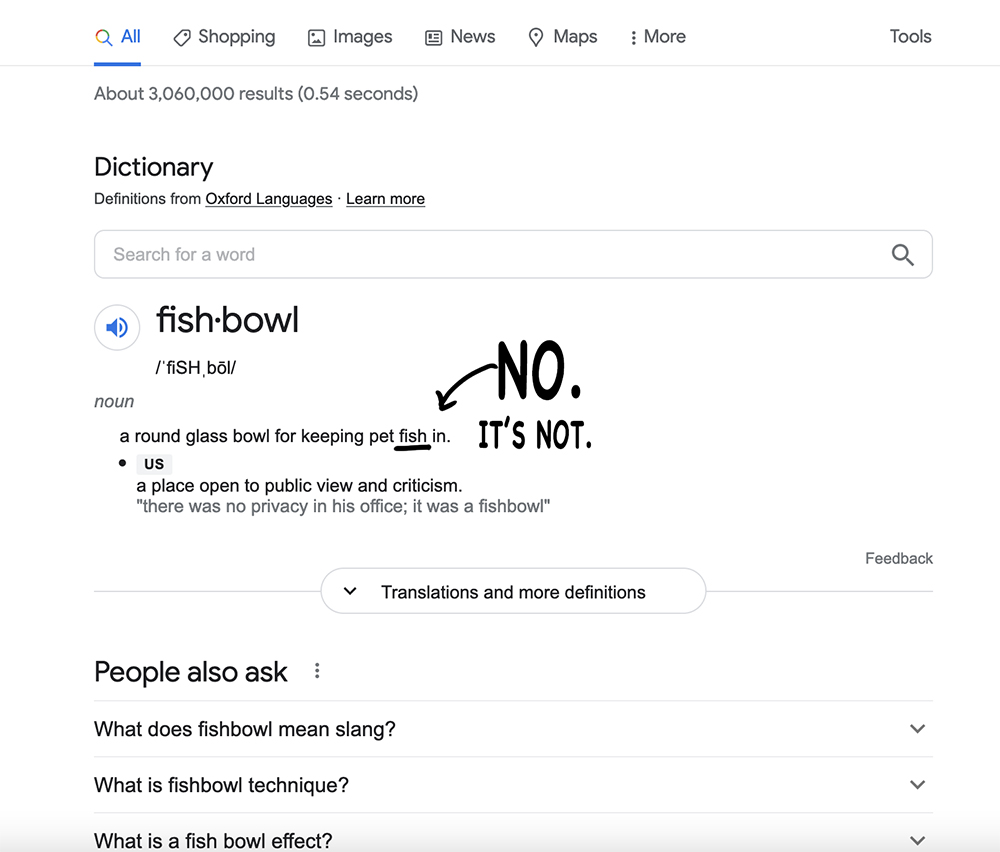
Fishbowls aren’t necessarily bad things. It all depends on how they’re used. They look cool, especially if you add some substrate, plants, a light and maybe a little pump to put out a gentle trickle of water. The good thing is that there are a few things that CAN be kept in fishbowls, even without a filtration system:
Plants like anacharis, hornwort and duckweed. Fertilizer can be added occasionally to supply nutrients to the plants.
Small snails like Ramshorns or Bladder snails. They will overpopulate the fishbowl eventually though, so their numbers must be kept in check for optimal living conditions. Nerite snails are even better. They won’t overpopulate the fishbowl as their eggs need brackish water to hatch, and they look beautiful. 2-3 Nerites can be comfortably kept in a 3 gallon fishbowl.
Fairy Shrimp, Daphnia and Brine Shrimp [aka Sea Monkeys] – aeration with a bubble stone is recommended
And, last but not least:
Opae Ula Shrimp, aka the Hawaiian Red Shrimp or Volcano Shrimp (Halocaridina rubra), a tiny brackish water shrimp that only grows to about 1-1.5 cm in size. A 2 gallon bowl is recommended as a minimum and no filtration or aeration is needed, and neither are any water changes (ever) which is both amazing and convenient. Actually, Opae Ula do best without any of those things.
But keeping fish in a fishbowl? No.

It really shouldn’t be called a fishbowl, but rather something like:
A small, round container for keeping certain small invertebrates and plants.

29 Sunday May 2022
Posted in Fish

Giant Colombian Ramshorn snails can be found in the Caribbean, Central America, and South America. They resemble regular Ramshorn snails as well as share some characteristics with Mystery Snails. “Marisas” breathe air at the surface and have trapdoors just like Mystery Snails, but they lay eggs underwater and have a flattened, disc shaped shell similar to a Ramshorn. They have big, easily visible eyes and long tentacles. Their bodies have a beautiful marbled pattern and the shells feature long, continuous yellow orange and black bands. They’re quite adventurous and move around the tank all day looking for food. They’re beautiful, undemanding and are excellent snails to keep on the aquarium cleanup crew.

Somehow, Marisas got a reputation for being plant destroyers, but really, they’re not any more destructive than a pack of regular Ramshorn snails. If anything, the latter snail species is one of the worst when it comes to aquarium plant destruction due to their fast rate of reproduction. Although Marisas are bigger, they have never seriously damaged any of the plants in my tanks. I’ve been keeping them for over a year now with plants like Anubias, Anacharis, Luffy Moss Balls, Java Fern and Dwarf Sagittaria. No problem! My tank’s still lush and green as ever. As adults, they reach about the same maximum size as Mystery Snails, about 2″.
So, no, Marisas are not some scary giant monsters that’ll mow down all the plants in your tank. They’re actually rather chill, peaceful scavengers with lovely speckled faces. They like zucchini, sweet peas and picking up whatever the fish have left uneaten on the tank floor. Like all snails, they need cuttlebones or mineral blocks to prevent calcium deficiency and weak shells.
Care and water parameters:
Tank size: 5-10 gallons or more is recommended
Care: easy
Water type: fresh water
pH 7.5-8.5
GH 7 – 25
KH 8 (optimal)
TDS 150-250
Temp: room temperature (66-68F or higher). No heaters are necessary.
Life span: about 3 years
Size: 2 – 2.2 inches
Behavior: peaceful
Diet: omnivore, scavenger
Available for purchase on eBay:
https://www.ebay.com/itm/175264249310?hash=item28ce9035de:g:VyYAAOSwJDZicMDa



05 Tuesday Feb 2019
Posted in Fish
Keeping decorative dwarf shrimp such as Cherry Shrimp is fun. It’s also a great way to get your feet wet in the hobby because they are relatively undemanding. Basically, you’re going to make a lot of mistakes in the beginning. It’s normal, but you’ll likely end up losing some stock. The reason I recommend Neocaridina Shrimp as a starter aquatic pet is because they do best when you don’t meddle. And, since they require very little care (or meddling :O) , they’ll do just fine in a 5 gallon with a couple of live plants and some basic water parameters.

A Cherry Shrimp (Neocaridina davidi)
Getting started
1) Get a 5 gallon tank and fill it with de-chlorinated tap water.
2) You can also add substrate like river sand, pebbles, gravel, etc. Use a pH neutral substrate for best results.
3) Add some live plants. Java Fern, Java Moss, Luffy Moss Balls, Brazilian Pennywort… any plants will generally do well with shrimp, as they only consume decaying plant matter without damaging new leaves.
4) Add a small corner sponge filter driven by a low power air pump. Lighting is optional. Daylight will do just fine.
5) Leave the whole setup for 3 weeks. Don’t do anything. Get a cover that covers the tank completely though. It can be just a simple plexiglass sheet. No fancy aquarium hoods needed. This will keep your shrimp pets from accidentally jumping out of the tank.
6) Buy some shrimp and acclimate them to the tank. The easiest acclimation method is to first float the bag of shrimp on the surface of the water in your tank for 10 minutes or so. Then cut open the bag and add a bit of water from your tank every 15 minutes until the volume doubles in size. Pour off a bit of the bag water into some container, and repeat adding tank water to the bag every 15 minutes or so. The whole process will take about an hour. Don’t rush this part. Shrimp are extremely sensitive to new water parameters. If you just drop them in your tank, chances are you will kill them. They will start dying off in droves after a few days (just trust me on this :P)
7) Leave the shrimp in their new tank for 3 weeks. Feed very sparingly, every 1-2 days and make sure any uneaten food is removed from the tank after 12-24 hours. Shrimp won’t starve even if you don’t feed them anything at all – an established tank has a lot of algae and biofilms for them to graze on.
Food
You do not need any special food, but you will need to supplement the tank with calcium. Shrimp need it for molting. Also, shrimp will eat sinking bottom feeder pellets, algae wafers, fish flakes, blanched vegetables like peas, broccoli and zucchini.

Ramshorn snails make a good clean up crew but they like to reproduce a lot. And I mean, A LOT.
My current Cherry Shrimp tank pH is 7.8; the kH is 7; TDS is at about 200; temperature: 70F. The light cycle is about 10 hours. You don’t need to adhere to these exact parameters. The main thing is to keep the conditions as stable as possible.
Lastly, be careful about bringing new animals or plants into the tank. Plants can carry trace amounts of copper (deadly to all invertebrates, including shrimp and snails), in addition to diseases. Quarantine any new plants in a separate bowl for a while. You might be surprised at how many uninvited snails, larvae and other things can emerge form the plants after about 24 hours in quarantine. You might also want to test the water for copper–plants are often fertilized with copper containing products, and can leach copper weeks after being soaked in a quarantine container.
Don’t worry about doing water changes too often. It’s actually bad for shrimp. One 25% water change every 3-4 weeks is fine. Keep the TDS between at 150-200. Eventually, you should see some berried females and a few weeks later, some very tiny shrimp!
Happy Shrimping!



05 Tuesday Feb 2019
Posted in Fish
Shipped a few more Mystery Snail orders today, this time experimenting with using heat packs, as most of these orders are going to the Eastern seaboard. The picture of the two Golden Mystery Snails shows two Mysteries of the same age–the larger one was brought up in warmer conditions and is now about 1″+. The smaller one is about 1/2″.
Thoughts on heat packs…
Umm, some of them just don’t work, while others provide only lukewarm temperatures. It’s tricky. I hope the snails will survive.
29 Tuesday Jan 2019
Posted in Fish
Some more photos from the life aquatic.


21 Monday Jan 2019
Posted in Fish